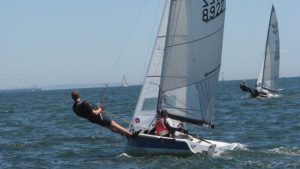

Prepare to Race – On the morning of the race, you will check the local forecast again to see how the predicted weather has changed or whether it is behaving as has been forecast.
Get Out On The Course Early
Get on the course 60 minutes before the start and sail as much of the first beat as possible.
Make mental notes of the wind patterns to establish which side of the course appears favoured. Work out whether the wind shifts are oscillating or persistent.
Compare what you are seeing with what has been predicted and start to make your plan for the first windward leg.
The main advantage of doing this is that if immediately after the start something changes, you will have the information to make a snap decision about whether to continue standing on or whether to tack.
Whilst sailing the first leg prior to the start you can establish whether your setting for the rig, sails and sheeting positions are correct.
These would have been set initially prior to leaving the beach based on information available at that time.
Check the current at different points on the racecourse matches with what you know about this venue. Find this out from previous regattas or local knowledge research.
Line Up Against Another Competitor
Even the best sailors benefit from lining up against another competitor prior to the start. Many of us have a tuning partner. If your regular mate isn’t there, find someone beneficial to work with.
So many questions can be answered by positioning your boat two lengths from a competitor and speed testing.
These tests can and should be lined up in advance with a reliable competitor. Their speed and abilities are known and they will show up on time at the designated spot.
Almost always prioritize tactical and boatspeed research over boat-handling practice, you are not likely to solve bigger boat-handling issues in the short period of time that is available to you.
Finally, allow an 8 to 10-minute chill period before the start. During this time discuss the upcoming race in a low-stress manner.
This gives the team an opportunity to re-evaluate sail selection, and then to fuel up and hydrate.
You are now ready to tackle any eventuality after the gun goes. You can make an informed tactical decision when something that was not predicted occurs.

